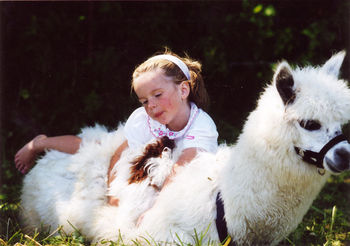Alpaca Facts
[an error occurred while processing this directive]Edit page New page Hide edit links
ALPACAS ARE AMAZING
ORIGIN
Alpacas were domesticated from the vicuna by the Incas over 5000 years ago and are among the most ancient of the world's domestic animals. The majority of the 3 million alpacas found in the world today inhabit the high plains regions of Chile, Bolivia, and Peru.
BEHAVIOR/INTELLIGENCE
Alpacas are very social and intelligent creatures. Alpacas do spit, but normally just at each other. Rarely do alpacas spit at people. A female will spit off a male, refusing his advances if she is pregnant. Alpacas tend to be docile and easy-going creatures that get along with people and other livestock. Young alpacas are readily halter trained. Alpacas are easily herded without a dog.
FIBER
The primary function of the alpaca is fiber production. This animal sports one of the most luxurious and valuable fibers that exists today. It is the combination of softness, tensile strength and variety of color that set alpaca apart from other luxury fibers. There is no need to dye the fiber in order to have a wide spectrum of color, as the alpaca is found naturally in a wide variety of hues and tones, including black, gray, brown, fawn, rose-gray, red, apricot and white. There are 22 internationally recognized colors of alpaca fiber, however approximately 95% of the worldwide alpaca population is white. The rarity of colored alpacas contributes to their value. Products created from alpaca fiber are comfortable to wear because of the lack of "prickle", due to the absence of guard hair. The fiber shaft is partly medullated. For this reason, garments made of alpaca are extremely lightweight, yet very warm. Once utilized by the Inca Royals, alpaca fiber today is a popular material for the works of top Italian designers.
ALPACA FIBER VS. SHEEP'S WOOL
There are a number of factors that set alpaca fiber apart from sheep's wool. Perhaps the most obvious difference is the wide range of color naturally occurring in the alpaca population that is not found in sheep.
A very important characteristic of alpaca fiber is the handle or the "feel". The pleasing softness felt when alpaca fiber is placed next to the skin can be attributed to a number of factors. The fineness of the fiber contributes to the luxurious silky feel. However, a very fine sheep fleece (i.e. Merino) may have a comparable fineness, but a more harsh handle. This is because handle is also related to additional factures such as scale structure.
Alpaca fleeces tend to yield a higher percentage of clean fiber. Alpaca is lanolin-free and can be spun directly off of the animal. Sheep's wool requires cleaning prior to spinning.
Alpaca fiber has a higher thermal capacity and is extremely light weight in comparison to sheep's wool.
SHEARING
Alpacas should be shorn once a year yielding 3-10 pounds of exquisite fleece. The fiber, virtually grease-free, can be handspun directly off of the animal. Hugo shears all of the alpacas at Alpacas de la Patagonia, as well as those of some of our clients.
BREEDING
Females are induced ovulators and therefore are ready to breed at most any time of the year. She will ovulate in response to mating and will normally spit off an advancing male if she is pregnant.
GESTATION
The gestation period is approximately 335 days.
BIRTHING
Alpacas normally give birth during the day and do not usually require human intervention. Out of hundreds of births that we have attended, we have yet to see a night birth. Shortly following birth, the mother will hum to her baby.
ALPACAS IN NORTH AMERICA
Most alpaca herds in North America are very small, housing less than 20 animals. These hardy animals are very adaptive and at present can be found on small acreage farms from Alaska to Hawaii.
CARE
Alpacas are simple to care for. They require little beyond regular worming and vaccinations, in addition to occasional trimming of their nails and teeth. They should be shorn annually.
FEED
Alpacas are modified ruminants. For thousands of years, alpacas have lived where grass grows sparsely. They require low amounts of protein in their feed to produce a high quality and healthy fleece. A good quality grass hay and/or pasture are optimum. Because 6-8 alpacas require only 1 acre of pasture, they are ideal for small acreage farms. Alpacas will not normally overeat. Unlike hoofed animals, their softly padded feet are extremely easy on pasture.
SHELTER
Alpacas originate in the high mountain areas of South America where they do not have any sort of protection from the harsh weather conditions. They are most content when they are outside. However some form of protection from the elements should be provided such as a 3-sided building. Alpacas will not normally challenge a fence.
MANURE
Conveniently, alpacas deposit their pellet-like manure in common dung piles, allowing for easy clean-up and natural protection against the spread of parasites. This low nitrogen fertilizer is a must for the garden.
LIFESPAN
Average lifespan is 20 years. Unlike most other types of livestock, alpacas are profitable without going to the slaughterhouse.
SIZE
Adult alpacas stand approximately 3 feet tall at the shoulder and weigh 100 - 150 pounds.
TERMINOLOGY
A baby alpaca is called a "cria". A female is called a "hembra" and a male is called a "macho".
TRAVEL
In our experience, alpacas travel very well. Upon sensing motion, they usually "kush" or lie down. We have extensive experience in transporting alpacas.
ALPACA REGISTRY
Virtually all of the alpacas in North American are registered. Parentage is confirmed through DNA testing.
INVESTMENT
Alpacas are not only enjoyable, but also profitable. Investing in alpacas is a good way to diversify any financial portfolio. Livestock has long been a traditional representation of wealth. Today wealth as a result of livestock ownership is not as common as it once was, but opportunities still exist. Raising alpacas can be a rewarding way to earn a source of revenue and live a satisfying lifestyle.
There are many tax advantage of alpaca ownership including the employment of depreciation, capital gains treatment, and the benefit of offsetting ordinary income from other sources with expenses from the ranching business.
Alpaca breeding allows for tax-deferred wealth building. A breeder can purchase alpacas and then allow the herd to grow over time without paying income tax on it's increased size and value. If the same amount of money was invested in a CD, any interest earned would be currently taxable. In addition, the CD could not be depreciated.
Alpacas in which you have a cost basis can be written off over a 5-year period if they are being held as breeding stock.
Capital improvements to the active or hands-on alpaca breeder's ranch can also be written off against income. Barns, fences, pond construction, driveways, and parking lots can be expensed over their useful life. Equipment such as tractors, pickups, trailers, etc. each have an appropriate schedule for write-off.
The sale of breeding stock qualifies for capital gains treatment. Ordinary income is taxed at a maximum rate of up to 31% and capital gains are taxed at rates of up to 20%.
The potential profit and tax advantages available to alpaca breeders are important, as is the lifestyle that raising these curious creatures brings to the whole family.








